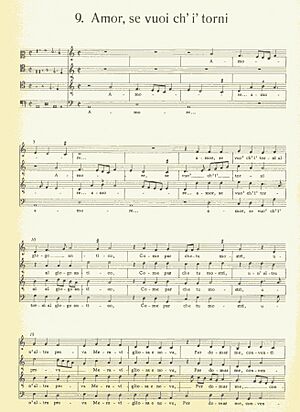Bernardo Pisano facts for kids
Bernardo Pisano (born October 12, 1490 – died January 23, 1548) was an Italian composer, priest, singer, and scholar. He lived during the Renaissance period. Pisano was one of the very first composers to write madrigals. He was also the first composer ever to have a printed book of his own non-religious music.
His Life Story
Bernardo Pisano was born in Florence, Italy. He might have spent some time in Pisa, which is why he was called "Pisano." When he was young, he sang and studied music at a church in Florence called Annunziata.
In 1512, he became the maestro di cappella there. This meant he was in charge of the music and supervised the choir singers. The powerful Medici family liked him. They gave him this church job and also a singing job in the Pope's special chapel in Rome in 1514. This happened right after Cardinal Giovanni de' Medici became Pope Leo X. Around this time, between 1512 and 1520, Pisano taught Francesco Corteccia, who later became an important organist and composer.
Pisano lived in Rome for most of the rest of his life. Besides singing in the Pope's choir, he received special church positions from the Pope. These included jobs at cathedrals in Seville and Lerida. From 1515 to 1519, he traveled between Florence and Rome, working in music in both cities. But by 1520, he settled in Rome, only visiting Florence sometimes.
In 1529, Pisano made a difficult choice. He returned to Florence when the city was under a different government, not controlled by the Medici family. Because he was close to the Medici, people thought he was a spy for the Pope. He was arrested, put in prison, and had a very hard time. In September 1529, the famous siege of Florence began. During this time, he was released from prison. In 1530, the Pope's army captured Florence, and the Medici family returned to power. After this dangerous experience, Pisano went back to Rome and stayed there.
In 1546, Pope Paul III made him the maestro di cappella of his own private chapel. Pisano held this important job for only two years before he passed away in 1548. One of the singers in this special group was Jacques Arcadelt, who would become even more famous than Pisano for his madrigals.
His Music and Influence
Bernardo Pisano wrote religious music in a serious, simple style. This music was likely used when he was in charge of music at the Annunziata church. However, he became most famous and important for his non-religious music. Pisano is considered by many to be the very first composer of madrigals.
In 1520, a printer in Venice named Ottaviano Petrucci published Pisano's book, Musica di messer Bernardo Pisano sopra le canzone del Petrarcha. This collection featured songs based on poems by Petrarch. Even though these pieces were not yet called "madrigals," they had many features that later became typical of madrigals. For example, they used serious poems, the words and their accents were placed very carefully, and the music often painted a picture of the words (called word-painting). This publication was also very special because it was the first time a printed book of non-religious music was entirely dedicated to one composer's work. Before this, printed music books were usually collections from many different composers.
Later composers who became famous for madrigals, like Costanzo Festa, Jacques Arcadelt, and Philippe Verdelot, knew Pisano's work. They learned from his style and copied some of his musical ideas.
Pisano's early non-religious music was typical of Italian music from the early 1500s. It was light, had active rhythms, and was usually for three voices singing together. Many of these pieces were ballatas or canzonettas. His later non-religious music, including the important 1520 collection, is best described as madrigal-like. The poems he used were sometimes serious and sometimes funny. Seven of the poems were by the famous writer Petrarch. The music carefully tried to show the feelings expressed in the poem. Often, the last line of the text was repeated for emphasis. This became a common feature in early madrigals. The music also varied, sometimes having all voices singing together and sometimes having different voices singing separate melodies. It also featured passages for groups of two, three, and four singers.
See also
 In Spanish: Bernardo Pisano para niños
In Spanish: Bernardo Pisano para niños


